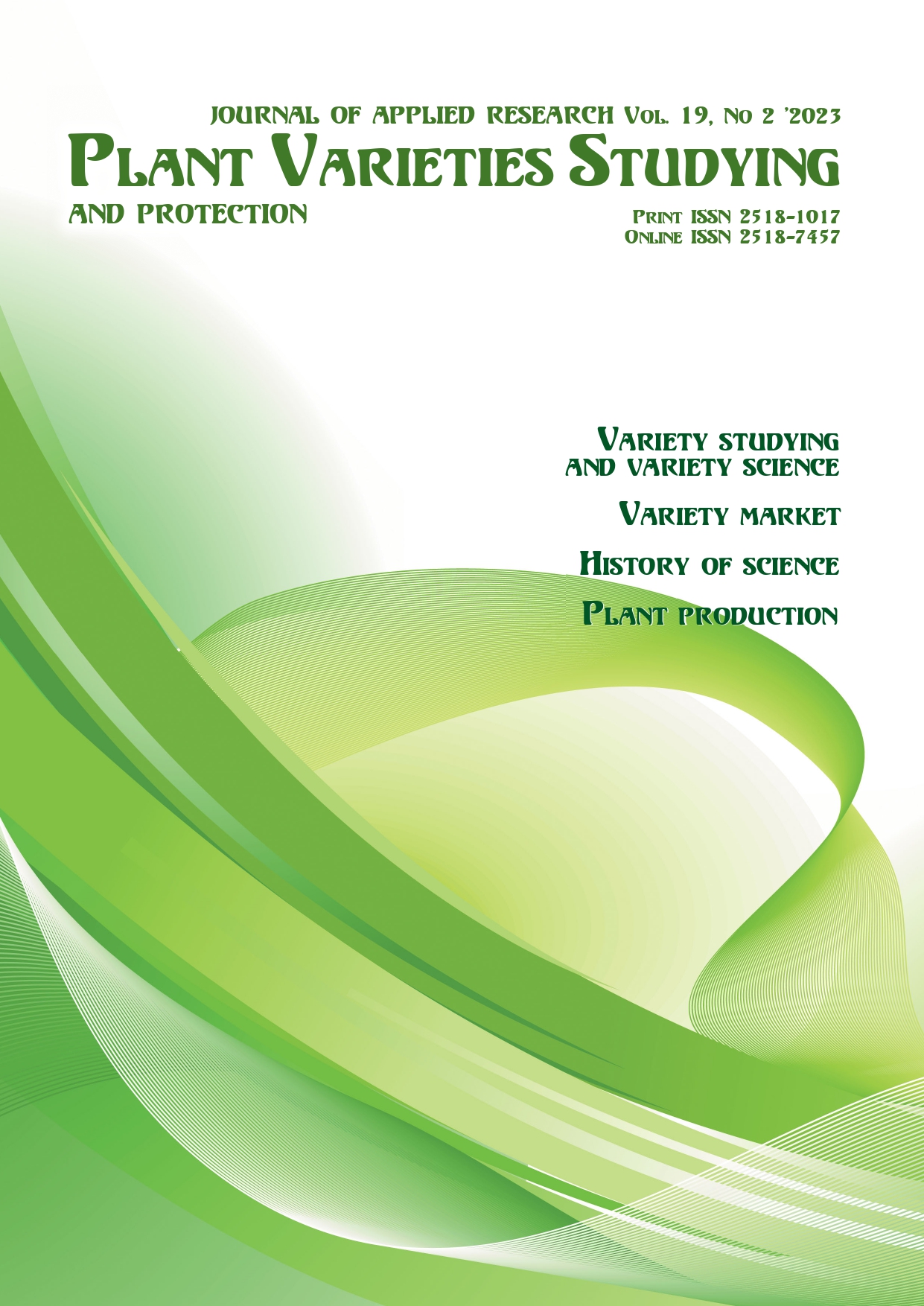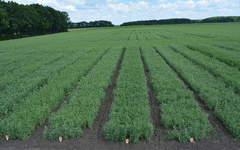Qualitative indicators of spring barley varieties (Hordeum vulgare L.) under different growing conditions
DOI:
https://doi.org/10.21498/2518-1017.19.2.2023.282554Keywords:
spring barley, quality, crop capacity, grain uniformity, protein content, correlational analysisAbstract
Purpose. To evaluate the quality indicators of spring barley seeds grown under different soil and climatic conditions.
Methods. Laboratory, calculation and statistical methods were used during the research, analysis and synthesis methods were used to draw conclusions.
Results. As a result of research, the dependence of spring barley quality indicators, namely: grain uniformity and protein content, on soil and climatic zones and growing conditions was revealed. Thus, grain uniformity ranged from 86.7% (high, Polissia) to 95.1% (very high, Forest Steppe) in the different test years. In 2021, thanks to favorable meteorological conditions during the growing season, its indicators increased by 4.3% in the Steppe, 4.6% in the Forest Steppe and almost 6.0% in Polissia compared to 2020. On average, the uniformity of grain grown in different branches of UIPVE increased by 5.6%. The maximum values were obtained for the varieties ‘Avus’ – 93.9% (Steppe), ‘Novyi Svitanok’ – 94.5–96.6% (Polissia, Forest Steppe). Depending on the soil and climate zone and the year of the experiment, the protein content in the grain varied from 10.9 (low, Steppe) to 13.4% (medium, Forest Steppe). On average, this indicator decreased by 2.5% in 2021 compared to 2020, and only in the Polissia zone it increased by 2.6%. The highest protein content was found in the varieties ‘Istr’ – 13.5–13.9% (Steppe and Forest Steppe) and ‘Hercules’ – 13.4% (Polissia). The varieties ‘Amadei’, ‘Istr’ and ‘Novyi Svitanok’ combined both economic and valuable traits. Optimum air temperature and high grain uniformity contribute to increasing the yield of spring barley. At the same time, during the formation of a high yield in the culture, the protein content in the grain decreases.
Conclusions. It was revealed that, on average, in 2020–2021, the uniformity of spring barley grain was 92.3% (Steppe), 95.4% (Forest Steppe) and 93.2% (Polissia); the protein content in the grains was 11.8% (Steppe), 12.4% (Forest Steppe) and 11.6% (Polissia). The formation of quality indicators of spring barley seeds was influenced by the growing conditions in the relevant soil and climatic zone.
Downloads
References
Fang, Y., Zhang, X., & Xue, D. (2019). Genetic analysis and molecular breeding applications of malting quality QTLs in barley. Frontiers in Genetics, 10, Article 352. doi: 10.3389/fgene.2019.00352

Ramakrishna, R., Sarkar, D., Schwarz, P., & Shetty, K. (2017). Phenolic linked anti-hyperglycemic bioactives of barley (Hordeum vulgare L.) cultivars as nutraceuticals targeting type 2 diabetes. Industrial Crops and Products, 107, 509–517. doi: 10.1016/ j.indcrop.2017.03.033

Tokhetova, L. A., Umirzakov, S. I., Nurymova, R. D., Daizhanova, B. K., & Akhmedova, G. B. (2020). Analysis of Economic-Biological Traits of Hull-Less Barley and Creation of Source Material for Resistance to Environmental Stress Factors. International Journal of Agronomy, 2020, Article 8847753. doi: 10.1155/2020/8847753

Hakala, K., Jauhiainen, L., Rajala, A. A., Jalli, M., Kujala, M., & Laine, A. (2020). Different responses to weather events may change the cultivation balance of spring barley and oats in the future. Field Crops Research, 259, Article 107956. doi: 10.1016/ j.fcr.2020.107956

Rötter, R. P., Palosuo T., Pirttioja, N. K., Dubrovsky, M., Salo, T., Fronzek, S., … Carter, T. R. (2011). What would happen to barley production in Finland if global warming exceeded 4 οC? A model-based assessment. European Journal of Agronomy, 35(4), 205–214. doi: 10/1016/j.eja.2011 06/003

Verma, S., Yashveer, S., Rehman, S., Gyawali, S., Kumar, Y., Chao, S., … Verma, R. P. S. (2021). Genetic and Agro-morphological diversity in global barley (Hordeum vulgare L.) collection at ICARDA. Genetic Resources and Crop Evolution, 68(4), 1315–1330. doi: 10.1007/s10722-020-01063-7

Kassie, M. M., Awoke, Y., & Demesie, Z. (2018). Evaluation of barley (Hordeum distichon L.) genotypes for grain yield and malting quality parameters at Koga Irrigation in Western Amhara Region. International Journal of Plant Breeding and Genetics, 12(1), 13–18. doi: 10.3923/ijpbg.2018.13.18
Hansen, P. M., Jørgensen, J. R., & Thomsen, A. (2002). Predicting grain yield and protein content in winter wheat and spring barley using repeated canopy reflectance measurements and partial least squares regression. The Journal of Agricultural Science, 139(3), 307–318. doi: 10.1017/S0021859602002320
Horash, O. S., & Klymyshena, R. I. (2020). The effect of foliar fertilization of malting barley plants on the protein content of grain. Bulletin of Agrarian Science, 4, 28–34. doi: 10.31073/agrovisnyk202004-04 [In Ukrainian]
Birch, C. G., & Long, K. E. (1990). Effect of nitrogen on the growth, yield and grain protein content of barley (Hordeum vulgare). Australian Journal of Experimental Agriculture, 30(2), 237–242. doi: 10.1071/EA9900237
Yu, W., Tan, X., Zou, W., Hu, Z., Fox, G. P., Gidley, M. J., & Gilbert, R. G. (2017). Relationships between protein content, starch molecular structure and grain size in barley. Carbohydrate Polymers, 155, 271–279. doi: 10.1016/j.carbpol.2016.08.078
 |
| 
Khokonova, M. B., & Adzhieva, A. A. (2019). Photosynthetic activity of spring barley plants depending on moisture provision. Amazonia Investiga, 8(23), 96–100. Retrieved from https://amazoniainvestiga.info/index.php/amazonia/article/view/853
Sterna, V., Bleidere, M., Sabovics, M., Auzins, A., Leimane, I., & Krievina, A. (2021). Improving nutritional value of products with flour of the hulless barley cultivar ‘Kornelija’ as an ingredient. Zemdirbyste-Agriculture, 108(1), 43–50. doi: 10.13080/z-a.2021.108.006
Newman, R. K., & Newman, C. W. (2009). Barley for food and health – science, technology and products. New York, NY: John Wiley & Sons
Narwal, S., Kumar, D., Sheoran, S., Verma, R. P. S., & Gupta, K. R. (2017). Hulless barley as a promising source to improve the nutritional quality of wheat products. Journal of Food Science and Tehnology, 54(9), 2638–2644. doi: 10.1007/s13197-017-2669-6
 |
| 
Klasyfikator pokaznykiv yakosti botanichnykh taksoniv, sorty yakykh prokhodiat ekspertyzu na prydatnist do poshyrennia [Classifier of quality indicators of botanical taxa, the varieties of which undergo examination for suitability for distribution]. (2019). Vinnytsia: Tvory. Retrieved from https://sops.gov.ua/uploads/page/vidanna/2019/1.pdf [In Ukrainian]
Tkachyk, S. O. (Ed.). (2016). Metodyka provedennia kvalifikatsiinoi ekspertyzy sortiv roslyn na prydatnist do poshyrennia v Ukraini. Zahalna chastyna [Methodology for the qualification examination of plant varieties for suitability for distribution in Ukraine. General part] (3rd ed., rev.). Vinnytsia: Korzun D. Yu. [In Ukrainian]
Tkachyk, S. O. (Ed.). (2016). Metodyka provedennia ekspertyzy sortiv roslyn hrupy zernovykh, krupianykh ta zernobobovykh na prydatnist do poshyrennia v Ukraini [Methodology for examination of plant varieties of the cereal, grain and leguminous group for suitability for distribution in Ukraine]. Vinnytsia: Korzun D. Yu. from https://sops.gov.ua/uploads/page/5a5f4147d3595.pdf [In Ukrainian]
Tkachyk, S. O. (Ed.). (2017). Metodyky provedennia kvalifikatsiinoi ekspertyzy sortiv roslyn na prydatnist do poshyrennia v Ukraini. Metody vyznachennia pokaznykiv yakosti produktsii roslynnytstva [Methods of conducting qualification examination of plant varieties for suitability for distribution in Ukraine. Methods of determining plant production quality indicators] (3rd ed., rev.). Vinnytsia: Korzun D. Yu. [In Ukrainian]
State Statistics Service of Ukraine. (2023). Ploshchi, valovi zbory ta urozhainist silskohospodarskykh kultur za yikh vydamy ta po rehionakh [Areas, gross harvests and productivity of agricultural crops by their types and by regions]. Kyiv: N.p. Retrieved Aptil 26, 2023, from https://www.ukrstat.gov.ua/ [In Ukrainian]
Sots, S., Chumachenko, Y., Kustov, I., & Kuzmenko, Y. (2020). Grain of naked oats and naked barley. Features of technological properties of grain. Scientific Works, 84(2), 5–9. doi: 10.15673/swonaft.v2i84.1879 [In Ukrainian]
Öztürk, İ. (2022). Assessment of environment effect on yield component in barley (Hordeum vulgare L.) genotypes under rainfed conditions. Scientific Papers of the Institute of Bioenergy Crops and Sugar Beet, 30, 6–14. doi: 10.47414/np.30.2022.268939
Shcatula, Y. M., & Kozachenko, M. I. (2021). Optimization of technological methods of cultivation of winter barley in conditions experimental field VNAU. Agriculture and Forestry, 22(3), 56–71. doi: 10.37128/2707-5826-2021-3-5 [In Ukrainian]
Prysiazhniuk, L. M., Khomenko, T. M., Liashenko, S. O., & Melnyk, S. I. (2022). Productivity indicators of new varieties of soft winter wheat (Triticum aestivum L.) depending on growing factors. Plant Varieties Studying and Protection, 18(4), 273–282. doi: 10.21498/2518-1017.18.4.2022.273989 [In Ukrainian]
Downloads
Published
How to Cite
Issue
Section
License
Copyright (c) 2023 A. M. Kyrylchuk, C. L. Chukhleb, N. P. Shcherbynina, I. V. Bezprozvana, S. O. Liashenko, V. D.

This work is licensed under a Creative Commons Attribution-ShareAlike 4.0 International License.
Starting in 2022, the copyright to the publication remains with the authors
Our journal abides by the CREATIVE COMMONS copyright rights and permissions for open access journals.
Authors, who are published in this journal, agree to the following conditions:
- The authors reserve the right to authorship of the work and pass the first publication right of this work to the journal under the terms of a Creative Commons Attribution License, which allows others to freely distribute the published research with the obligatory reference to the authors of the original work and the first publication of the work in this journal.
- The authors have the right to conclude separate supplement agreements that relate to non-exclusive work distribution in the form in which it has been published by the journal (for example, to upload the work to the online storage of the journal or publish it as part of a monograph), provided that the reference to the first publication of the work in this journal is included.

























 Ukrainian Institute for Plant Varieties Examination
Ukrainian Institute for Plant Varieties Examination  Селекційно-генетичний інститут
Селекційно-генетичний інститут Institute of Plant Physiology and Genetics of the National Academy of Sciences of Ukraine
Institute of Plant Physiology and Genetics of the National Academy of Sciences of Ukraine
 The National Academy of Agrarian Sciences of Ukraine
The National Academy of Agrarian Sciences of Ukraine